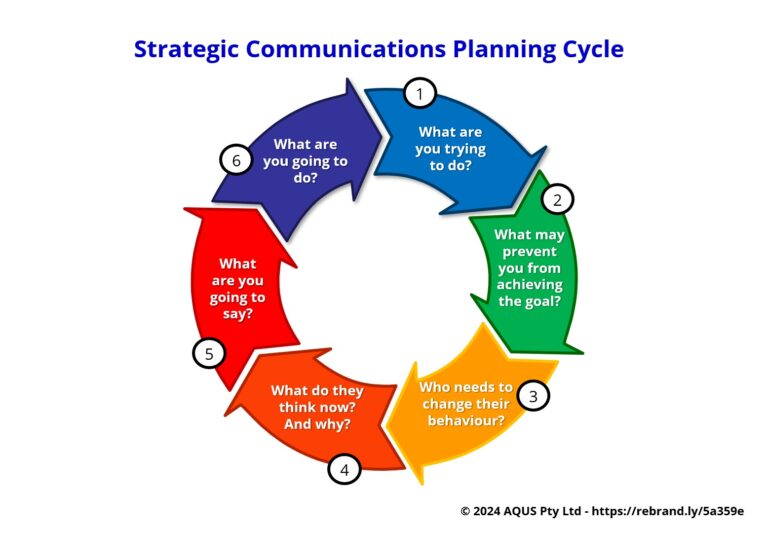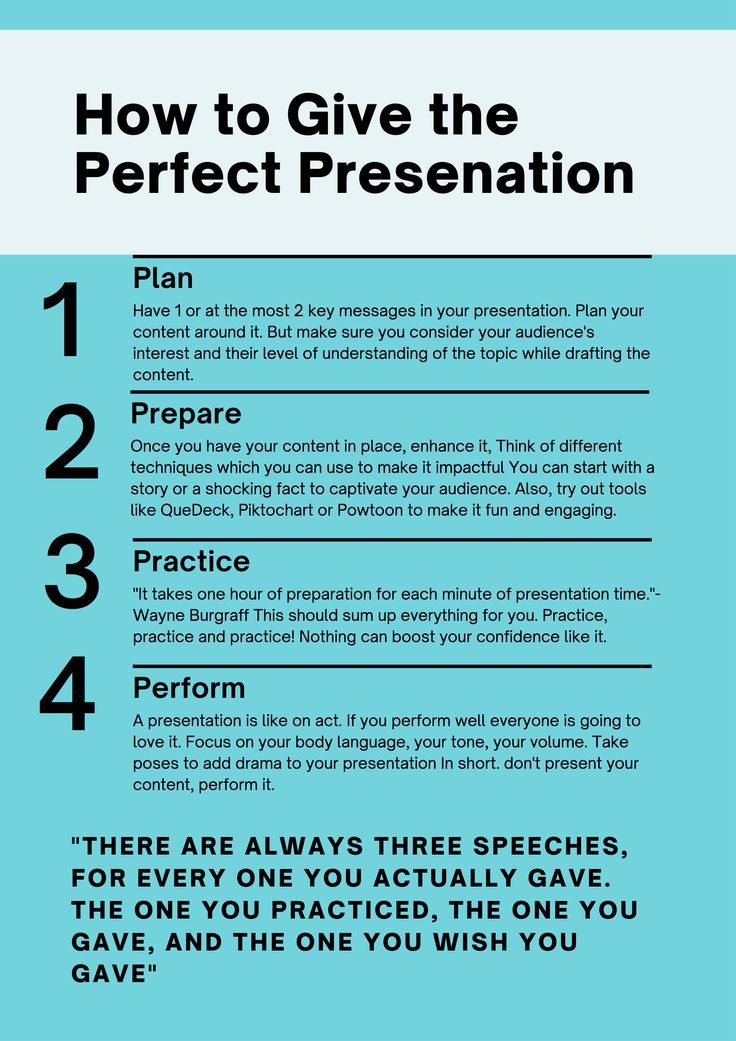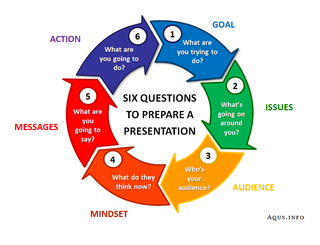A popular question in many communications workshops is how to prepare a presentation most quickly. Is there some type of simple methodology or process to use when time is limited?
The answer is yes. From an earlier post outlining the standard six questions of communications planning, I adapted those points slightly to show how they also can be applied quickly to prepare a presentation of any type.
You can find the original six questions in the chart to the above right, or at the previous link.
I’ve put the adapted questions to prepare a live speech or a written presentation below right.
The key word is prepare.
More important, these questions are not the order or structure of the presentation. These questions focus on the necessary information you need to gather or ask yourself before you start writing the presentation.
Once you have the answers to these questions, you can then prepare to organise them into an appropriate presentation structure.
1. What's the goal of the presentation?
Specifically, what do you need to happen at the conclusion of the presentation?
What business result or communications objective is driving this presentation?
Is there a specific outcome you want to occur?
What do you want your audience – the decision maker(s) listening to or reading your presentation – to do explicitly? Tell them clearly and plainly at the beginning so they can listen better.
At the end of the presentation, if your audience does not understand what you expect of them, they likely will not agree with you.
As always, it’s never a bad idea to remind yourself to write SMART objectives.
Finally, here’s something you might want to consider at the start. What’s your Plan B if the decision maker says no? Also, you should tell the decision makers (and audience generally) what the impact will be if they say no.
2. What's the problem you're trying to solve?
Many work presentations revolve around a problem or an issue that needs to be addressed. Remember, the ‘problem’ is not necessarily damaging or catastrophic. A problem is generally some hurdle or obstacle keeping the organisation, department or team from achieving its goal.
Even if your presentation is about the future – next year’s plan, for example – there is usually some problem in the business environment, community or background that needs to at least be acknowledged, if not addressed specifically.
What problem is your presentation about? How are you going to bring it up? Will your tactics actually address the problem, and how? By when?
Do you need to make this problem specific? Some senior people don’t like focusing too much attention on the problem, which is understandable (sort of). But still, should you make your decision makers or audience aware of the problem precisely?
What are you doing to the problem? Are you trying to eliminate it? (Can you actually get rid of it entirely? At what cost of resources?) Or, is your presentation to make the problem less, smaller, or less relevant? Sometimes the plan hopes to contextualise the problem, put it into perspective as it were. Know what you’re doing with the problem. And, be prepared for questions about the problem from the decision maker.
For example, I was listening to a presenter – the head of a bank’s ATM network – talk about their department’s 10-year strategic plan. The CEO interrupted half-way through the presentation to ask about their thoughts on the environment, particularly as it related to rubbish. Without pause, the presenter dismissed the CEO’s questions as if the question was irrelevant to the strategic plan. The CEO interrupted again and asked why they weren’t concerned with the amount of paper rubbish being left behind when ATM customers didn’t take their receipts, often infuriating the community around the physical ATM. The presenter instantly tried to backtrack, but the damage was done.
Finally, as you prepare the presentation, you should consider any opportunities that could be leveraged to add balance. What trends may give added urgency to your recommendation or hypothesis? Be careful not to position opportunities over issues, as opportunities don’t stand in the way of your success, issues do.
3. Who is your audience?
Oftentimes, an internal business presentation is really about two audiences.
The group of people you want to encourage to think or do something different. They are the focus of your proposal or recommendation. More often than not, these people are external, such as customers or vendors.
Just as important,. the other audience is …
The decision maker. the person in the audience or the senior reader who will give you the authority or approval to move ahead.
You need to consider both equally as you prepare your presentation.
This question (#3) is focused on the decision maker(s) who will give you approval, authority or endorsement to move forward.
To get your proposal approved most quickly, you need to consider several aspects from the decision maker’s POV, especially from a top-down perspective of the organisation. (In other words, how will your presentation fit or sync with other projects going on inside the organisation now or in the future.)
Before you prepare your presentation, is there agreement between you and the decision maker on the objective or goal? I’d argue it’s as important to have agreement on the problem to solve as well. Do not solve the wrong problem.
What’s the level or trust or rapport between the two of you?
How much does this person respect your consideration? That is, do you properly research the situation to remove as much bias as possible? Have you spoken to key people to other’s advice and input? Of your research, how much do you try to prove yourself right vs. how much time do you spend trying to also prove yourself wrong?
Do you report to the decision maker? If you don’t, is there any benefit to having a discussion with your actual supervisor about the decision maker? Can they give you any advice or past history which may help you better prepare your presentation.
Does the decision maker already have an answer or their own specific ideas to your proposal or recommendation?
If you agree on most aspects of the goal and problem, how much of a proposal do you really need? (Don’t overwrite a presentation.)
If you are in conflict, can you address any of the potential issues in advance? Can you speed up or smooth out any issues beforehand? Can you share a brief conclusion or recommendation in advance?
In general, don’t turn the proposal into a game show. There should be minimal surprise when you present your presentation.
As for the other audience – the target audience – let’s move to question #4.
4. What does your audience think, believe or behave now? And why?
Let’s begin with a basic truth. You cannot convince anyone to change their attitude or behaviour if you don’t know what they think now about a specific topic. (This is as true with the decision maker as it is with your target audience.)
Whether you like it or not, people’s perceptions are real. It often has little to do with accuracy.
If your proposal or recommendation wants to encourage people to change their mind, attitude of behaviour, how have you gone about learning – from their point-of-view – what they think about the situation they’re in?
What’s their opinion of your topic? What happened to create this impression, perception or belief?
Are you a trustworthy party to listen to? Who else might the target audience turn to for advice or information? How do your messages compare to these other (potentially opposite, or worse negative) messages?
Have you reached out to them in advance to get a complete perspective? How would they solve their own problem? Is there any way to collaborate on potential solutions so the target audience at least feels some control in the issue? Can you build in early buy-in from the start?
If the change you’re asking for requires resources – time, energy, information – you need to address those resources in your recommendation. You may also need to consider some type of ‘change program’ to work in parallel with your recommendation.
Finally, if it’s not clear, always define your audience by two aspects:
Demographics: quantitative figures (cold hard facts) that define vital or social statistics
Psychographics: qualitative data that defines their behaviour, attitudes and lifestyle choices
Remember too that rational facts persuade: they don’t motivate. Emotional ‘facts’ motivate, but without a rational base, decisions can lead to ‘buyer’s remorse.’
Read Demographics and Psychographics a recap.
5. Messages: What are you going to say to change your audience's mind?
When your proposal is approved, you will need to talk to the target audience, either directly (face-to-face) or through a channel (website, a marketing campaign). Give adequate consideration to develop precise, considered messages to try and convince them of the change ahead.
What is your single message in one sentence? If you cannot say it in one sentence and in one breath, it’s too long.
If they forget everything you said, what is the one takeaway message that should remain in their memory?
Make your message actionable. Avoid passive action, such as …
Remember this …
I hope that you …
There is no urgency to passive action. It’s also very difficult to measure.
Messages are organised by the Rule of 3. Try The Rule of 3 in Communications.
Good messages have a number of key attributes. Read How to Say The Right Thing for more information.
6. Action: What do you want your audience to do, specifically? And by when?
People often consider this question first, which is fine – but you should re-ask it after you have prepared your presentation, so that your proposal has consistency from beginning to end.
As you reach the final question, it’s also a good time as a parallel thought to begin to articulate the potential questions you may get. Are they clearly answered in your proposal? Also, what are the questions you don’t want to get, and do you have answers for them in advance? You will kill your reputation if you can’t answer a question that the decision maker or audience member thinks is legitimate.
Once you have legitimate and honest answers to these six questions, you can now start to structure your presentation in slides.
If I can add one additional tip, don’t begin constructing your presentation by opening PowerPoint and starting to write. Get your thoughts organised before you write. It will save you editing time later on.
Here’s another point of view to prepare a presentation, from Pennsylvania State University (‘Penn State’).
I’ve also had this graphic for some time (see right), but I don’t know the author or designer. Please let me know if you have any background. I’d love to cite its creators.
Any other suggestions, tips or advice on preparing for a presentation? Please add your thoughts and comments below.




No comment yet, add your voice below!